US Telecom Towers Market Size
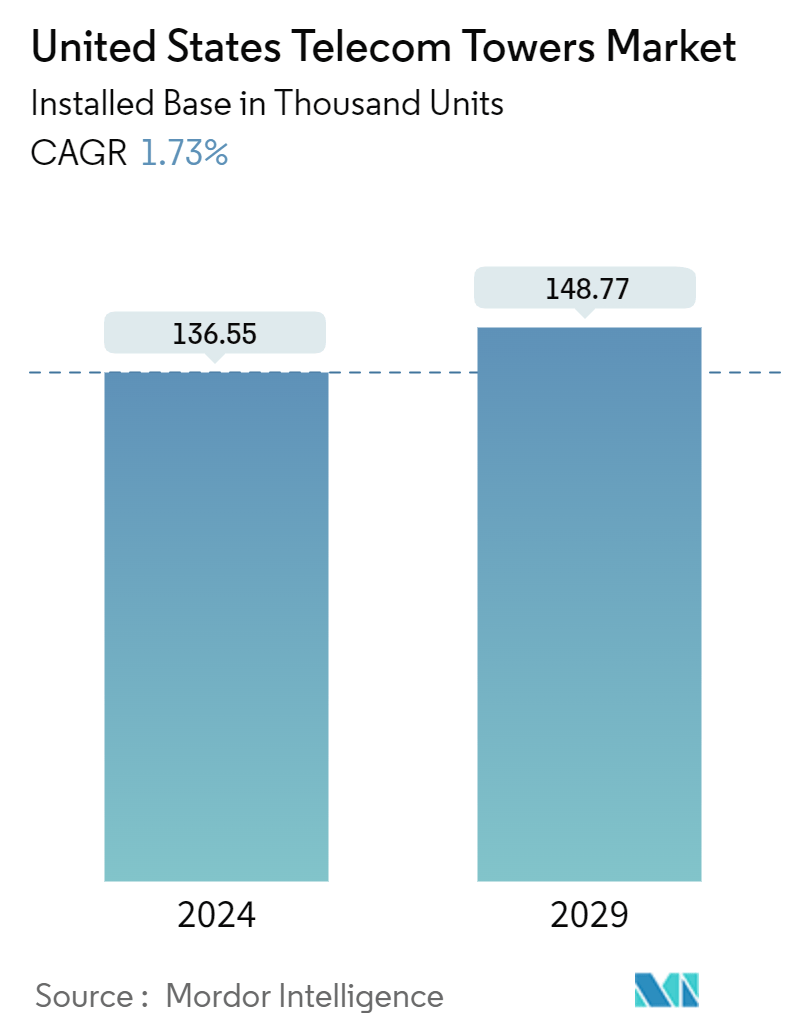
| Study Period | 2019 - 2029 |
| Base Year For Estimation | 2023 |
| Forecast Data Period | 2024 - 2029 |
| Historical Data Period | 2019 - 2022 |
| CAGR (2024 - 2029) | 1.73 % |
| Market Concentration | High |
Major Players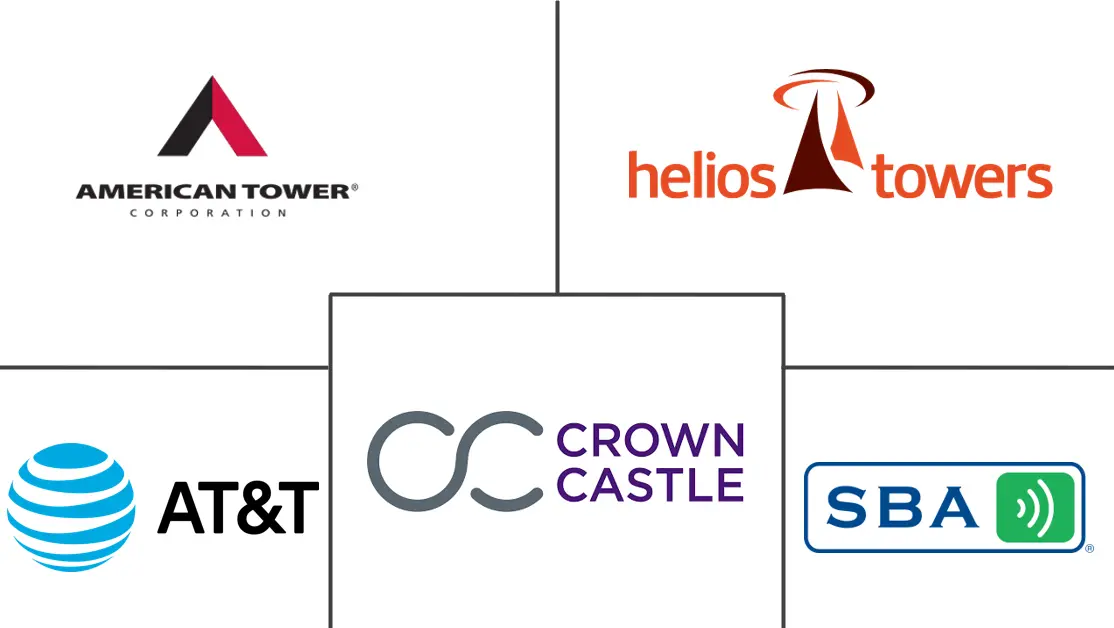
*Disclaimer: Major Players sorted in no particular order |
US Telecom Towers Market Analysis
The United States Telecom Towers Market size in terms of installed base is expected to grow from 136.55 Thousand units in 2024 to 148.77 Thousand units by 2029, at a CAGR of 1.73% during the forecast period (2024-2029).
The United States telecom tower market plays a crucial role in supporting the nation’s rapidly growing demand for reliable wireless communication. With the rise of mobile devices, data consumption, and next-generation technologies like 5G, telecom towers have become essential to the country's digital infrastructure. The market includes a variety of stakeholders, including telecom tower companies, mobile network operators, and wireless infrastructure providers, all working together to enhance the country's network capacity.
Regulatory Landscape of Telecom Towers in the U.S.:
The regulation of telecommunication towers is a significant aspect of the U.S. market. Federal, state, and local regulations govern tower deployment, maintenance, and environmental compliance. The Federal Communications Commission (FCC) sets many of these guidelines, impacting everything from site approval to spectrum allocation. Compliance with environmental concerns, such as radiation limits and power supply sustainability, is critical, influencing both the design and placement of towers.
- FCC Guidelines: The FCC’s regulatory framework plays a central role in how telecom tower infrastructure grows, influencing areas such as spectrum allocation and site licensing.
- Environmental Impact: Regulations also ensure that telecom towers meet environmental compliance standards, with emphasis on reducing radiation and promoting sustainability.
- Local Regulations: State and municipal bodies provide additional regulatory oversight, affecting the pace of telecom tower deployment across regions.
- Rural Deployment Policies: There is a growing regulatory focus on rural tower deployment to ensure coverage expansion into underserved areas.
Telecom Tower Infrastructure Growth in the U.S.:
Telecom tower infrastructure growth in the U.S. has accelerated due to the rising need for network expansion. As urban and rural areas alike increase their reliance on mobile communication, telecom companies are investing heavily in both ground-based and rooftop installations.
- Network Expansion: Increased mobile and data usage in both urban and rural regions is driving extensive investments in ground-based and rooftop towers.
- Private Ownership and Joint Ventures: Many telecom towers are owned by private firms, mobile operators, or through joint ventures. These partnerships facilitate rapid network growth.
- Tower Sharing: To minimize costs and expedite network rollout, telecom companies increasingly rely on tower-sharing agreements, reducing both environmental impact and infrastructure costs.
- Impact of COVID-19: The pandemic shifted network usage patterns, increasing the importance of reliable rural telecom towers, as companies adjusted strategies to meet surging demand in underserved areas.
U.S. 5G Rollout as a Catalyst for Expansion
The rapid deployment of 5G technology is driving significant demand for telecom tower infrastructure growth in the U.S. The fifth-generation mobile network promises faster speeds, lower latency, and higher capacity, all of which require more densely deployed telecom towers.
- 5G Infrastructure Growth: Telecom tower infrastructure growth in the USA is accelerating with the rollout of 5G technology, which demands extensive upgrades to macro towers and small cells.
- Small Cell Deployment: Beyond macro towers, small cell deployment is becoming essential, particularly in densely populated urban areas. These smaller units are often installed on streetlights and buildings, helping enhance network coverage.
- Rural 5G Expansion: In rural areas, extending 5G telecom towers is crucial for bridging the digital divide, though challenging due to lower population density and higher installation costs.
- Tower Leasing: The evolving model of telecom tower leasing in the USA allows telecom companies to focus on their core activities while renting infrastructure from tower operators, further driving market demand.
Environmental Concerns in Power Supply and Tower-sharing
The U.S. telecom tower market faces growing environmental challenges, particularly related to power supply systems. With the rising pressure to transition toward sustainable energy, telecom tower operators are increasingly exploring renewable energy sources for powering their infrastructure.
- Renewable Energy Integration: Telecom tower companies are adopting solar and wind energy solutions, especially in remote areas where traditional grid access is limited, thus reducing reliance on diesel generators.
- Environmental Sustainability Goals: Telecom firms are increasingly focused on reducing their carbon footprints, investing in green energy solutions, and upgrading existing infrastructure to support renewable power sources.
- Tower-sharing as an Environmental Strategy: Sharing towers between telecom providers reduces the environmental impact of building new towers, particularly in urban settings where infrastructure overlaps.
- Challenges in Tower-sharing: While sharing towers can reduce environmental footprints, it raises concerns about competitive advantages, with some larger telecom companies hesitant to share their assets.
US Telecom Towers Market Trends
Adoption of 5G Technology Fuels Telecom Tower Infrastructure Growth
The U.S. telecom towers market is witnessing rapid growth, fueled by the increasing demand for high-speed wireless connectivity and infrastructure upgrades. The market landscape is being redefined with the proliferation of 5G technology and a shift toward operator-owned towers.
- 5G Deployment Driving Demand: The adoption of 5G technology is a major driver of telecom tower infrastructure growth, with extensive upgrades required to support faster data speeds and more reliable connectivity.
- Small Cell Deployment: A key trend in the U.S. telecom tower market is the widespread deployment of small cell sites, especially in densely populated urban centers, to increase network capacity.
- Rural Tower Expansion: Closing the digital divide is leading to significant growth in rural telecom towers, where leasing space on these towers is becoming a critical revenue source for mobile carriers.
- Market Forecast: Industry research predicts robust growth in the U.S. telecom tower market size, with investments in 5G and network upgrades expected to drive demand through 2025.
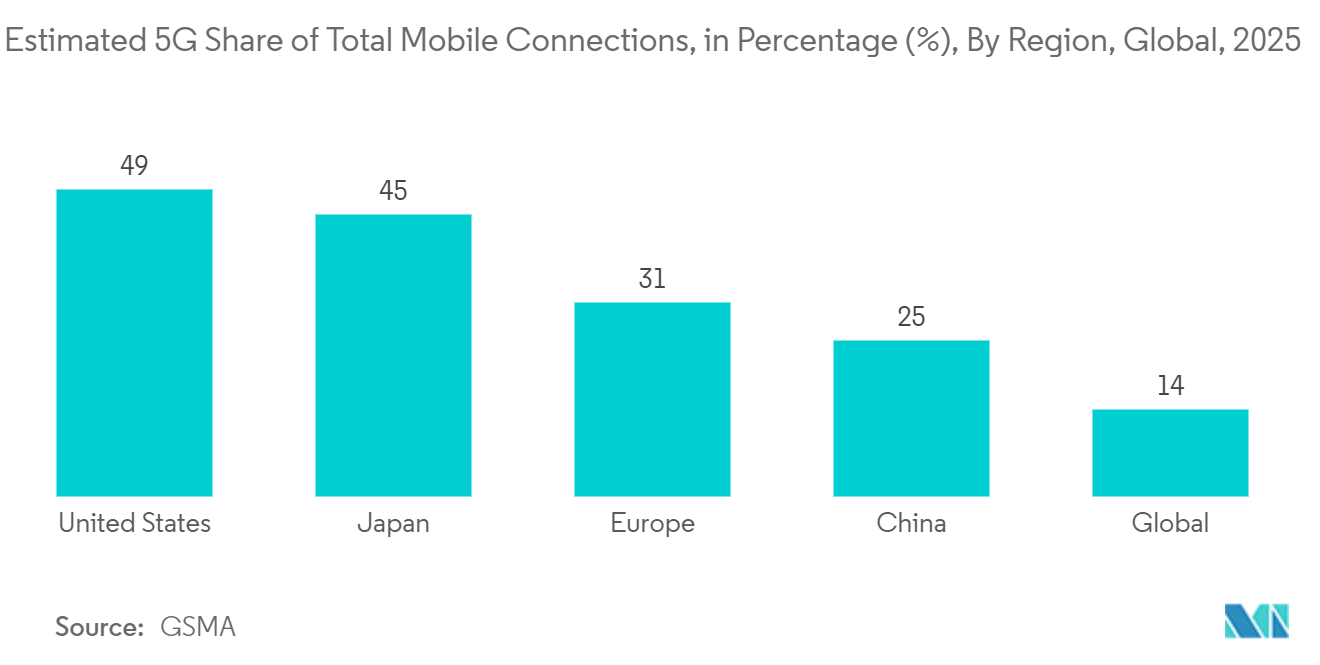
Operator-Owned Towers Hold Significant Share in the Market
The dominance of operator-owned towers is another important trend in the U.S. telecom tower market. Companies like AT&T and Verizon are increasingly owning their tower infrastructure to reduce costs and accelerate the deployment of 5G technology.
- Control Over Infrastructure: Owning telecom towers provides operators greater control over network expansion and reduces reliance on third-party leasing.
- Market Consolidation: The U.S. telecom tower market has seen significant mergers and acquisitions, with large operators acquiring smaller firms to scale their operations.
- Advantages of Operator-Owned Towers: These towers enable faster rollout capabilities, which are crucial for meeting growing demand in the competitive wireless infrastructure market.
- Regulatory Landscape Impact: Telecom tower regulations in the USA can create hurdles for smaller companies, but larger operators are better positioned to navigate these challenges and enhance their market share.
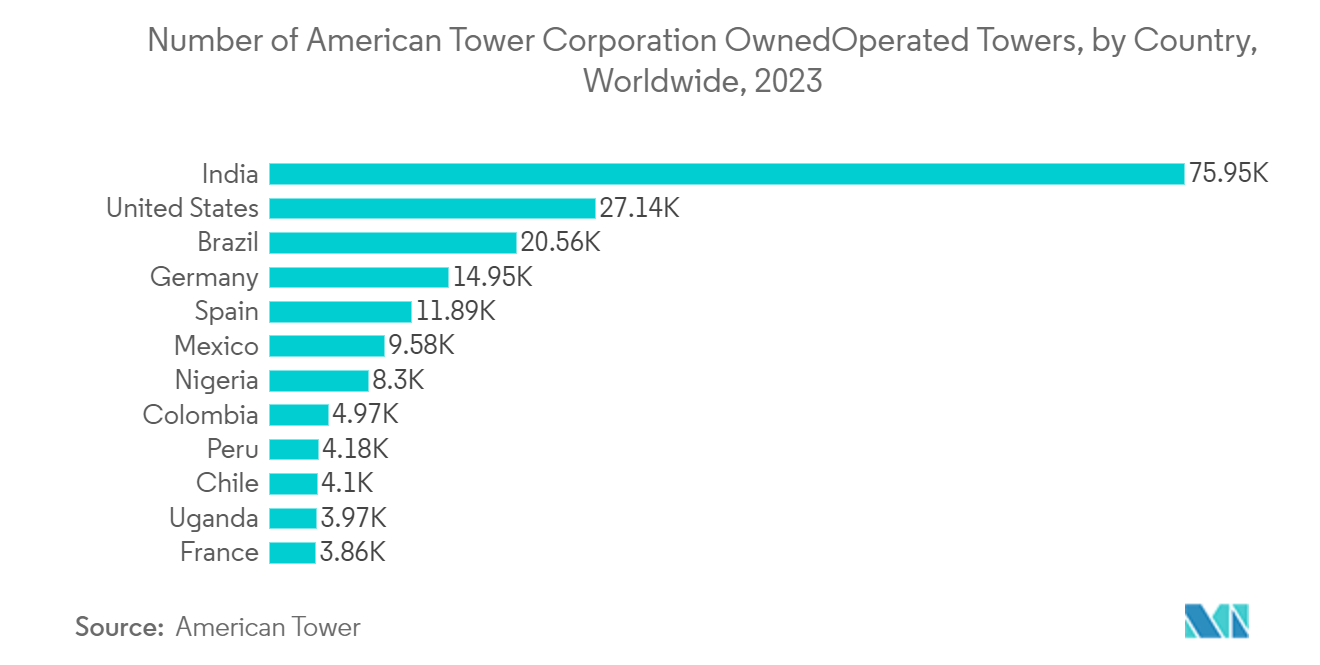
US Telecom Towers Industry Overview
The U.S. telecom towers market is highly consolidated, with a few key players controlling a substantial share of the market. These companies dominate the landscape through long-term contracts and significant capital investments.
Market Leaders: ATC IP LLC, SBA Communications Corporation, and Crown Castle International Corp. are leading the U.S. telecom tower market, focusing on infrastructure expansion and strategic partnerships.
Infrastructure Investments: Market leaders are aggressively investing in expanding their tower networks and integrating new technologies to support 5G services.
Competitive Strategies: Innovation in tower designs, long-term contracts with wireless carriers, and partnerships with 5G service providers are critical for maintaining market leadership.
Future Growth: The expansion of 5G networks and the demand for enhanced connectivity will drive future success strategies, positioning key players for sustained growth.
US Telecom Towers Market Leaders
-
ATC IP LLC
-
Helios Towers plc
-
SBA Communications Corporation
-
AT & T Intellectual Property
-
Crown Castle International Corp.
*Disclaimer: Major Players sorted in no particular order
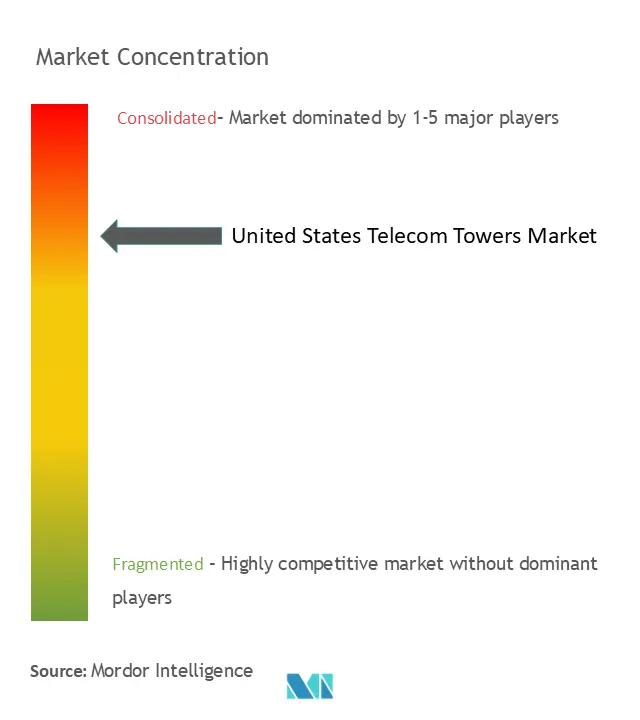
US Telecom Towers Market News
- July 2024 - Verizon is reportedly considering the sale of 5,000 to 6,000 cell towers in the US, potentially bringing in over USD 3 billion, as part of a broader trend among telecom companies to sell off infrastructure assets to raise funds for network upgrades and debt reduction. This potential sale, following Verizon's previous tower asset sale in 2015 and similar moves by competitors like AT&T, highlights the ongoing restructuring of the US telecom tower market as carriers seek to optimize their assets and focus on core network operations.
- June 2024 - Crown Castle, a major player in the US telecom tower market with over 40,000 towers, is facing challenges in building new cell towers due to opposition from residents and municipalities, leading the company to shift its focus towards small cells as an avenue for growth. As the US telecom market consolidates to three major players, Crown Castle is adapting its strategy by expanding its small cell network, which currently includes around 120,000 units on air or under contract, while also preparing for a USD 200 million revenue decrease in early 2025 due to the T-Mobile-Sprint merger.
US Telecom Towers Market Report - Table of Contents
1. INTRODUCTION
- 1.1 Study Assumptions and Market Definition
- 1.2 Scope of the Study
2. RESEARCH METHODOLOGY
3. EXECUTIVE SUMMARY
4. MARKET INSIGHTS
- 4.1 United States Telecom Towers Market Overview
- 4.2 United States Regulation of Telecommunication Towers
-
4.3 Industry Attractiveness - Porter's Five Forces Analysis
- 4.3.1 Bargaining Power of Suppliers
- 4.3.2 Bargaining Power of Consumers
- 4.3.3 Threat of New Entrants
- 4.3.4 Threat of Substitutes
- 4.3.5 Intensity of Competitive Rivalry
- 4.4 Assessment of the impact of COVID-19 on the Telecom Tower landscape in the United States
-
4.5 Market Drivers
- 4.5.1 5G Deployments are a Major Catalyst for Growth in the Cell-tower Leasing Environment
-
4.6 Market Challenges
- 4.6.1 Environmental Concerns about Power Supply Systems to Towers and Tower-sharing between Telecom Companies
- 4.7 Tower Climber Landscape in the United States
5. MARKET SEGMENTATION
-
5.1 By Fuel Type
- 5.1.1 Renewable
- 5.1.2 Non-renewable
-
5.2 By Installation
- 5.2.1 Rooftop
- 5.2.2 Ground-based
-
5.3 By Ownership
- 5.3.1 Operator-owned
- 5.3.2 Joint Venture
- 5.3.3 Private-owned
- 5.3.4 MNO Captive
6. COMPETITIVE LANDSCAPE
-
6.1 Company Profiles*
- 6.1.1 ATC IP LLC
- 6.1.2 Helios Towers plc
- 6.1.3 SBA Communications Corporation
- 6.1.4 AT & T Intellectual Property
- 6.1.5 Crown Castle International Corp.
- 6.1.6 Vertical Bridge
- 6.1.7 United States Cellular Co.
- 6.1.8 Melody Wireless Infrastructure
- 6.1.9 Insite Wireless Group
- 6.1.10 BNSF Railroad
- 6.1.11 Tillman Infrastructure LLC
7. INVESTMENT ANALYSIS AND MARKET OUTLOOK
** Subject To AvailablityUS Telecom Towers Industry Segmentation
A Telecommunication Tower refers to various types of towers such as monopoles, tripoles, lattice towers, guyed towers, self-support towers, poles, masts, or similar structures. These towers are utilized to hold one or more telecommunication antennae for radio communications. They can be situated on the ground or on a building's roof, and may also have an equipment shelter with electronic devices. These towers do not have full-time staff and only need occasional maintenance.
The study tracks the telecom tower landscape in terms of tower count, ownership type, and type of energy source in the US. In addition to the key market metrics, we will also cover the trends related to the following: telecom tower climber demographics in the US; coverage of the role of turf vendors and the specific programs commissioned by the network providers; and key regulations and controls put in place to mitigate the environmental and safety regulatory landscape. The report also covers the impact of COVID-19 on the market.
The United States telecom towers market is segmented by fuel type (renewable, non-renewable), by installation (rooftop, ground-based), and by ownership (operator-owned, JV, private-owned, MNO captive). The market sizes and forecasts are provided in terms of installed base (unit) for all the above segments.
| By Fuel Type | Renewable |
| Non-renewable | |
| By Installation | Rooftop |
| Ground-based | |
| By Ownership | Operator-owned |
| Joint Venture | |
| Private-owned | |
| MNO Captive |
US Telecom Towers Market Research FAQs
How big is the United States Telecom Towers Market?
The United States Telecom Towers Market size is expected to reach 136.55 thousand units in 2024 and grow at a CAGR of 1.73% to reach 148.77 thousand units by 2029.
What is the current United States Telecom Towers Market size?
In 2024, the United States Telecom Towers Market size is expected to reach 136.55 thousand units.
Who are the key players in United States Telecom Towers Market?
ATC IP LLC, Helios Towers plc, SBA Communications Corporation, AT & T Intellectual Property and Crown Castle International Corp. are the major companies operating in the United States Telecom Towers Market.
What years does this United States Telecom Towers Market cover, and what was the market size in 2023?
In 2023, the United States Telecom Towers Market size was estimated at 134.19 thousand units. The report covers the United States Telecom Towers Market historical market size for years: 2019, 2020, 2021, 2022 and 2023. The report also forecasts the United States Telecom Towers Market size for years: 2024, 2025, 2026, 2027, 2028 and 2029.
US Telecom Towers Industry Report
United States Telecom Towers Market Research
The United States telecom towers market is a cornerstone of the nation's growing wireless communication infrastructure, driven by increasing mobile device usage, data consumption, and the expansion of 5G networks. Our industry report provides a comprehensive analysis of key factors influencing market growth, such as telecom tower leasing USA, small cell deployment USA, and regulatory shifts that shape the tower installation landscape. Additionally, it examines the role of U.S. telecom tower companies in rural and urban expansions, along with insights into mergers and acquisitions driving market consolidation. The report pdf delivers actionable data and trends essential for stakeholders to stay ahead in this competitive market.
Stakeholders benefit from this industry research by gaining insights into the U.S. mobile network expansion and its impact on telecom tower demand forecasts. The report covers telecom tower infrastructure growth USA, regulatory considerations, and the increasing role of 5G telecom towers in the U.S. Whether it's understanding the dynamics of telecom tower regulations USA or evaluating market leaders like American Tower and Crown Castle International, our in-depth analysis provides valuable market data and predictions to support strategic decisions. All of these insights are compiled in an easy-to-read report pdf format, ensuring that stakeholders have access to up-to-date information for guiding business growth and investment strategies.



